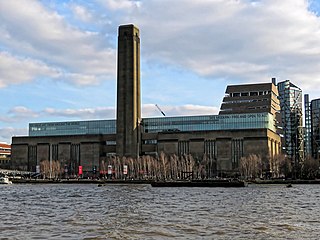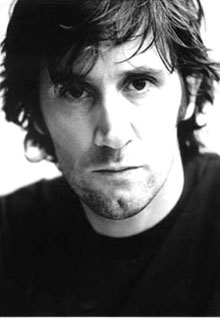
Tate Modern is an art gallery in London, housing the United Kingdom's national collection of international modern and contemporary art. It forms part of the Tate group together with Tate Britain, Tate Liverpool and Tate St Ives. It is located in the former Bankside Power Station, in the Bankside area of the London Borough of Southwark.

Tate is an institution that houses, in a network of four art galleries, the United Kingdom's national collection of British art, and international modern and contemporary art. It is not a government institution, but its main sponsor is the UK Department for Culture, Media and Sport.

Murray Bookchin was an American social theorist, author, orator, historian, and political philosopher. Influenced by G. W. F. Hegel, Karl Marx, and Peter Kropotkin, he was a pioneer in the environmental movement. Bookchin formulated and developed the theory of social ecology and urban planning within anarchist, libertarian socialist, and ecological thought. He was the author of two dozen books covering topics in politics, philosophy, history, urban affairs, and social ecology. Among the most important were Our Synthetic Environment (1962), Post-Scarcity Anarchism (1971), The Ecology of Freedom (1982), and Urbanization Without Cities (1987). In the late 1990s, he became disenchanted with what he saw as an increasingly apolitical "lifestylism" of the contemporary anarchist movement, stopped referring to himself as an anarchist, and founded his own libertarian socialist ideology called "communalism", which seeks to reconcile and expand Marxist, syndicalist, and anarchist thought.

An Internet café, also known as a cybercafé, is a café that provides the use of computers with high bandwidth Internet access on the payment of a fee. Usage is generally charged by the minute or part of hour. An Internet café will generally also offer refreshments or other services such as phone repair. Internet cafés are often hosted within a shop or other establishment. They are located worldwide, and many people use them when traveling to access webmail and instant messaging services to keep in touch with family and friends. Apart from travelers, in many developing countries Internet cafés are the primary form of Internet access for citizens as a shared-access model is more affordable than personal ownership of equipment and/or software. Internet cafés are a natural evolution of the traditional café. As Internet access rose many pubs, bars, and cafés added terminals and eventually Wi-Fi hotspots, eroding the distinction between the Internet café and normal cafés.

Richard William Hamilton was an English painter and collage artist. His 1955 exhibition Man, Machine and Motion and his 1956 collage Just what is it that makes today's homes so different, so appealing?, produced for the This Is Tomorrow exhibition of the Independent Group in London, are considered by critics and historians to be among the earliest works of pop art. A major retrospective of his work was at Tate Modern in 2014.
net.art refers to a group of artists who have worked in the medium of Internet art since 1994. Some of the early adopters and main members of this movement include Vuk Ćosić, Jodi.org, Alexei Shulgin, Olia Lialina, Heath Bunting, Daniel García Andújar, and Rachel Baker. Although this group was formed as a parody of avant garde movements by writers such as Tilman Baumgärtel, Josephine Bosma, Hans Dieter Huber and Pit Schultz, their individual works have little in common.

Angus Fairhurst was an English artist working in installation, photography and video. He was one of the Young British Artists (YBAs).

Ralf Winkler, alias A. R. Penck, who also used the pseudonyms Mike Hammer, T. M., Mickey Spilane, Theodor Marx, "a. Y." or just "Y" was a German painter, printmaker, sculptor, and jazz drummer. A neo-expressionist, he became known for his visual style, reminiscent of the influence of primitive art.

Stan Douglas is a Canadian artist based in Vancouver, British Columbia.

Natalie Bookchin is an artist based in Brooklyn, New York. She is well known for her work in media. She was a 2001-2002 Guggenheim Fellow. Her work is exhibited at institutions including PS1, Massachusetts Museum of Contemporary Art, the Museum of Contemporary Art in Barcelona, KunstWerke, Berlin, the Generali Foundation, Vienna, the Walker Art Center, the Whitney Museum of American Art, and the Shedhale in Zurich. Her works are in a variety of forms – from online computer games, collaborative performances and "hacktivist" interventions, to interactive websites and widely distributed texts and manifestos. In her work, she explores some of the far-reaching consequences of Internet and digital technologies on a range of spheres, including aesthetics, labor, leisure, and politics. Much of Bookchin's later works amass excerpts from video blogs or YouTube found online. From 1998 to 2000 she was a member of the collective RTMark, and was involved in the gatt.org prank they organized spoofing the 1999 General Agreement on Tariffs and Trade talks

Nettime is an internet mailing list proposed in 1995 by Geert Lovink and Pit Schultz at the second meeting of the "Medien Zentral Kommittee" during the Venice Biennale. Since 1998, Ted Byfield and Felix Stalder have moderated the main list, coordinated moderation of other lists in the nettime "family," and maintained the site as their nexus.
Yael Kanarek is an Israeli American artist based in New York City that is known for pioneering use of the Internet and of multilingualism in work of art.

Abraham Cruzvillegas is a Mexican visual artist. He is best known for his work with found objects, and particularly his ongoing "autoconstrucción" project.

Fran Ilich Morales Muñoz is a Mexican writer and media artist who principally works on the theory and practice of narrative media. Since 2010 Ilich lives in New York City.

Daniel García Andújar is a self-taught, outsider visual media artist, activist, and art theorist from Spain. He lives and works in Barcelona. His work has been exhibited widely, including Manifesta 4, the Venice Biennale and documenta 14 Athens, Kassel. He has directed numerous workshops for artists and social collectives worldwide.

Internet art is a form of new media art distributed via the Internet. This form of art circumvents the traditional dominance of the physical gallery and museum system. In many cases, the viewer is drawn into some kind of interaction with the work of art. Artists working in this manner are sometimes referred to as net artists.
Tom Corby and Gavin Baily (1970) are two London based artists who work collaboratively using public domain data, climate models, satellite imagery and the Internet. Recent work has focused on climate change and its relationship to technology and has involved collaborations with scientists working at the British Antarctic Survey. Corby and Baily are founder members of the Atmospheric Research Collective, an experimental artist group which works in collaboration with climate scientists. For an overview of recent works see "An interview with artist and writer Tom Corb y".
Naeem Mohaiemen uses film, photography, installation, and essays to research South Asia's postcolonial markers. His projects on the 1970s revolutionary left explored the role of misrecognition within global solidarity.

Ivan Pope is a British technologist, involved in a number of early internet developments in the UK and across the world, including coining the term cybercafe at London's Institute of Contemporary Arts. He was a founder of two of the first internet magazines, The World Wide Web Newsletter, and later .net magazine in the UK. In 1994 he founded Webmedia to professionalise the process of web site design and build. In 1995 he was involved with the creation of the domain name management company NetNames. Pope is now a writer and a noted proponent of the dérive.

documenta X was the tenth edition of documenta, a quinquennial contemporary art exhibition. It was held between 21 June and 28 September 1997 in Kassel, Germany. The artistic director was Catherine David. This was the first time a woman was appointed as artistic director of documenta. It is also the first time that the website of the exhibition was conceived as an artistic part of it. Catherine David chose the Swiss curator Simon Lamunière to conceive, design and curate the project. Part of documenta X was the experimental performance space and digital platform "Hybrid WorkSpace", curated by Klaus Biesenbach, Nancy Spector, and Hans-Ulrich Obrist. The space was designed by architect Eicke Becker and featured important performances, among them the famous Christoph Schlingensief performance titled "Mein Filz, mein Fett, mein Hase, 48 Stunden Überleben für Deutschland" during which several artists were arrested. Florian Schneider used "Hybrid WorkSpace" as an opportunity to initiate the No one is illegal network.
















